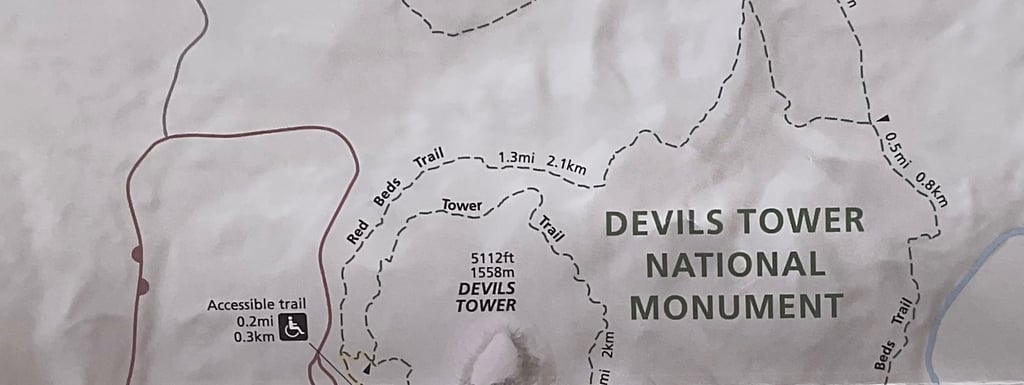Exploring America: The Devil’s Tower
First National Monument
Hayley Jones
9/17/20258 min read


Introduction to Devil's Tower
Devil's Tower, situated in the northeastern part of Wyoming within the renowned Black Hills region, is a remarkable geological feature that holds the distinction of being the first national monument in the United States. Established in 1906, this iconic formation rises majestically to an altitude of 1,267 feet above the surrounding landscape, making it a prominent landmark that captures the attention of visitors from around the globe. Its striking vertical columns, formed by the solidification of molten rock, create a unique appearance that distinguishes this butte from other natural formations.
The cultural significance of Devil's Tower extends beyond its geological marvels. For many Native American tribes, including the Lakota, Cheyenne, and Arapaho, the site is imbued with deep spiritual meaning and historical narratives that have been passed down through generations. The Tower, known in Lakota as "Bear Lodge," features prominently in various tribal legends, often representing a sacred place where significant events took place. This connection between the monument and indigenous cultures underscores the importance of preserving both the natural and cultural heritage associated with the area.
Visitors who come to explore Devil's Tower are treated to breathtaking views and numerous recreational opportunities. The surrounding terrain offers a diverse range of flora and fauna, along with trails for hiking and climbing. The Tower itself is a world-class climbing destination, drawing both novice and experienced climbers who seek to ascend its towering walls. As such, Devil's Tower serves not only as a testament to America's geological history but also as a key to understanding the cultural narratives that enrich its significance. Overall, this magnificent natural monument stands as a symbol of the intricate relationship between the land and the people who have inhabited it throughout history.
Hiking Trails Around Devil's Tower
Devil's Tower National Monument is an outdoor haven, offering a variety of hiking trails that cater to outdoor enthusiasts across all skill levels. One of the most popular trails is the Joyner Ridge Trail, which extends for 1.5 miles. This moderately easy trek is characterized by breathtaking panoramic views of the surrounding landscape. As hikers ascend, they are rewarded with sweeping vistas that highlight the unique geological features of the area.
Another noteworthy trail is the Red Beds Trail, which measures 2.8 miles in length. This trail presents a slightly greater challenge, making it suitable for those seeking a more vigorous hike. The Red Beds Trail is rich in biodiversity, allowing hikers to encounter an array of flora and fauna endemic to the region. Along this path, visitors can observe various plant species and, with some luck, wildlife such as deer and numerous bird species.
The most popular trail, the Tower Trail, spans 1.3 miles & offers a distinct experience as it circumnavigates the base of the iconic Devil's Tower. This trail allows visitors to appreciate the striking rock formations up close, immersing them in the geological wonders of this national monument. As hikers navigate the Trail, they may spot signs of wildlife, including black-tailed prairie dogs or squirrels, while enjoying the shadows cast by the mighty tower.
For those looking for a shorter yet scenic experience, the South Side/Valley View Trail provides an accessible 0.6-mile route. This easy trail allows hikers to take in the natural beauty of the monument without a strenuous effort. Overall, the varied hiking options around Devil's Tower make it an ideal destination for both casual walkers and seasoned hikers, ensuring memorable experiences in this unique natural setting.
Wildlife and Night Sky Observation
The area surrounding Devil's Tower National Monument is teeming with a diverse range of wildlife, providing ample opportunities for visitors to engage in wildlife observation. Among the various species that inhabit this remarkable region are white-tailed deer, which are often spotted grazing at dawn or dusk. Bird enthusiasts will find excitement in observing a variety of avian species, notably the majestic American bald eagle, which perches near the Tower and soars above the canyons. Additionally, visitors may encounter playful prairie dogs, swift coyotes, and numerous other native animals that call this environment home.
The best times for wildlife observation are typically during early morning and late afternoon when these animals are most active. Moreover, the fluctuation in light throughout the seasons affects animal behavior, making spring and early summer particularly fruitful for sightings as newborn wildlife becomes more adventurous. Ensuring that you maintain a respectful distance and quiet demeanor will enhance your chances of witnessing the wildlife's natural behaviors without causing disturbance.
In addition to the vibrant wildlife, Devil's Tower offers a unique advantage for stargazers. The area's relatively low light pollution presents an exceptional backdrop for exploring the night sky. As night falls, visitors can witness breathtaking celestial events and clearly defined constellations, such as Ursa Major and Taurus, which are easily visible from various vantage points around the monument. Those interested in enhancing their stargazing experience should consider visiting during meteor showers, such as the Perseids in August or the Geminids in December, which provide stunning displays of shooting stars.
To maximize your experience, bring binoculars for better visibility of celestial bodies and a star chart or stargazing app to guide your observations. With careful planning and a little patience, a visit to Devil's Tower can be a memorable blend of wildlife encounters and captivating nights under the stars.
Devil's Tower Trading Post: Gateway Services
Situated at the threshold of the iconic Devil's Tower National Monument, the Devil's Tower Trading Post serves as a welcoming gateway for visitors seeking to enhance their experience. This charming establishment not only offers essential services but also cultivates a unique atmosphere that captures the essence of the surrounding natural beauty.
One of the main attractions of the Trading Post is its extensive range of souvenirs, which cater to various interests and preferences. From locally crafted artwork to themed apparel featuring the monument itself, visitors can find the perfect memento to commemorate their journey. These souvenirs not only serve as reminders of the monument's splendor but also support local artisans and contribute to the regional economy.
For those looking to cool off after a day of exploration, the Trading Post boasts an array of delectable ice cream treats that are sure to delight both young and old. With flavors inspired by the region, guests can indulge in a refreshing break while enjoying the serene surroundings. The availability of free Wi-Fi access further enhances the visitor experience, allowing guests to share their adventures with friends and family or plan their next stops within the park.
The back deck of the Trading Post presents a remarkable vantage point for visitors, offering breathtaking views of Devil's Tower against the backdrop of the expansive Wyoming landscape. This inviting space encourages guests to unwind, reflect on their day, or simply enjoy the artistry that nature has to offer. By providing such distinctive amenities and services, the Devil's Tower Trading Post plays a significant role in ensuring that every visitor's experience is both enjoyable and memorable, fostering a sense of community amongst locals and tourists alike.
Cultural Significance and Native American Legends
Devil's Tower, proclaimed as America’s first national monument in 1906, possesses profound cultural and spiritual importance for several Native American tribes, including the Lakota, Cheyenne, and Arapaho. The striking geological formation is not just a remarkable natural feature; it is also enveloped in rich mythology and revered narratives that serve to shape the cultural identity of these indigenous communities. The tower, known in Lakota as 'Bear Lodge', embodies legends associated with creation, endurance, and the interconnectedness of the natural world.
Various tribes recount stories detailing the origins of Devil's Tower, with each narrative offering unique insights into their cultural beliefs. One prevalent legend among the Lakota tells of a group of young girls who were saved from a giant bear by Spirit Beings. The tower emerged as they were whisked away to safety, with the bear clawing at the tower's sides, leaving marks that can still be seen today. This story not only encapsulates the natural beauty of the monument but also emphasizes themes of protection and bravery, reinforcing the bond between the tribes and the land.
Moreover, the Cheyenne tell tales reflecting their cultural history and moral lessons surrounding respect for the earth and its inhabitants, portraying the tower as a symbol of resilience and community. For these tribes, the narratives linked to Devil's Tower serve as vital conduits for passing down traditions and teachings, maintaining their cultural vitality in an ever-changing world.
Overall, the legends and myths associated with Devil's Tower highlight the deep reverence that Native American tribes hold for this monument. It is a crucial part of their identity and continues to inspire both respect and a profound connection to the land, emphasizing the significance of preserving such cultural heritage sites for future generations.
Geology of Devil's Tower
Devil's Tower, located in northeastern Wyoming, is an extraordinary natural formation that is renowned for its unique geological characteristics. The tower, designated as America's first national monument in 1906, is primarily composed of igneous rock that was created through a process known as volcanic intrusion. This geological phenomenon occurs when molten rock from beneath the Earth's crust forces its way upward but does not erupt, cooling and solidifying underground. Over millions of years, erosion has exposed the tower, highlighting its striking features.
The composition of Devil's Tower is primarily basalt, which solidified into columnar jointing—a striking feature visible along the tower's sides. Columnar jointing results from the cooling and contraction of the volcanic rock, leading to the formation of vertical columns that can be seen rising from the base of the monument to its flat summit. These columns typically range in diameter and height, contributing to the mesmerizing visual of the structure against the Wyoming skyline. Surrounding the tower, one can observe sedimentary rocks, which provide insights into the geological history of the region.
Understanding the geological context of Devil's Tower involves recognizing several key concepts. The term "intrusion" refers to the process of magma penetrating existing rock formations, while "erosion" describes the natural forces, such as wind and water, that wear away rocks and soil, ultimately revealing hidden structures. The interplay of volcanic activity and erosional forces has created a fascinating landscape that attracts geologists and tourists alike. The unique geology not only defines Devil's Tower but also emphasizes the Earth's dynamic processes over geological time, making it a significant site for geological study and appreciation.
Visitor Information and Guidelines
When planning a visit to Devil's Tower, it is essential to understand the visitor information and guidelines to ensure a safe and enjoyable experience. The monument, recognized as America’s first national monument, welcomes guests year-round, and admittance fees help maintain the park's beauty and services. Typically, entry fees are modest, but it is noteworthy that active military personnel and their dependents are eligible for free entry, allowing those who serve our country to enjoy this stunning natural landmark without charge.
As you prepare for your visit, it is important to be mindful of the park’s regulations, particularly concerning pets. While dogs and other pets are allowed in designated areas, they must always be on a leash no longer than six feet. This policy not only protects the local wildlife but also ensures a peaceful atmosphere for all visitors. Being respectful of these rules enhances the visitor experience and aids in the conservation efforts of this unique environment.
In addition to self-guided exploration, Devil's Tower offers ranger-led programs for those wishing to enhance their understanding of the monument’s natural and cultural history. These educational sessions allow guests to engage with knowledgeable staff and gain insights into the geology and significance of the Tower. For outdoor enthusiasts, climbing is a popular activity at Devil's Tower, and while climbers are encouraged to take advantage of this opportunity, they are advised to familiarize themselves with climbing regulations to ensure safety and preservation of the area. By considering these guidelines, visitors can plan their trips effectively and enjoy all that this magnificent national monument has to offer.

Stay Connected. Stay Driven.
© 2025. All rights reserved.
Chicago IL/Lyons NE/Augusta GA
